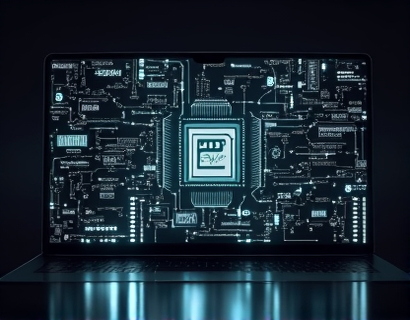Mastering DeFi: Introducing the Next-Gen Web3 Wallet for Seamless Crypto and Token Management
The landscape of cryptocurrency and decentralized finance, or DeFi, has evolved significantly over the past few years. As more individuals and institutions recognize the potential of blockchain technology, the demand for efficient and secure tools to manage digital assets has surged. Among the latest innovations in this space is the introduction of a next-generation Web3 wallet, designed to revolutionize the way users interact with cryptocurrencies and tokens. This wallet aims to provide a seamless, secure, and user-friendly experience, making DeFi more accessible and efficient for both crypto enthusiasts and seasoned DeFi users.
The traditional approach to managing digital assets often involves a maze of different wallets, each with its own set of limitations and complexities. Users frequently face challenges such as fragmented user experiences, security concerns, and the need to constantly monitor multiple platforms. The new Web3 wallet addresses these issues head-on by offering an integrated solution that streamlines access, storage, and transactions of various digital assets. This article delves into the features and benefits of this innovative wallet, exploring how it is reshaping the DeFi ecosystem.
Key Features of the Next-Gen Web3 Wallet
One of the standout features of this Web3 wallet is its comprehensive support for a wide range of cryptocurrencies and tokens. Unlike traditional wallets that may support only a limited set of assets, this wallet boasts an extensive library of compatible tokens, including major cryptocurrencies like Bitcoin, Ethereum, and popular altcoins, as well as lesser-known tokens from various DeFi protocols. This broad compatibility ensures that users can manage all their digital assets in one place, eliminating the need to switch between multiple wallets.
Security is paramount in the world of cryptocurrency, and this wallet does not compromise on this aspect. It employs state-of-the-art encryption techniques and multi-signature authentication to safeguard user funds. The wallet also features real-time transaction monitoring and alerts, allowing users to stay informed about their asset movements and potential security threats. Additionally, the wallet supports hardware wallet integration, providing an extra layer of security for sensitive transactions.
User experience is another critical aspect of this Web3 wallet. The interface is designed to be intuitive and user-friendly, with a clean and modern design that simplifies navigation. Users can easily access their asset balances, transaction history, and wallet settings without encountering complex menus or hidden options. The wallet also includes a built-in educational resource center, offering tutorials and guides to help new users understand the basics of DeFi and maximize the wallet's features.
Streamlined Transactions and Smart Contract Support
Transactions in the DeFi space can be cumbersome, especially when dealing with complex smart contracts. The next-gen Web3 wallet simplifies this process by providing a streamlined interface for executing transactions and interacting with smart contracts. Users can compose and sign transactions directly within the wallet, reducing the risk of errors and enhancing the overall efficiency of their DeFi activities.
The wallet supports advanced features such as batch transactions, allowing users to send multiple cryptocurrencies in a single transaction, which can significantly reduce gas fees and transaction times. It also includes a smart contract explorer, enabling users to inspect and understand the code and parameters of various DeFi protocols before engaging with them. This level of transparency and control empowers users to make informed decisions and avoid potential pitfalls.
Interoperability and Cross-Chain Capabilities
One of the most exciting aspects of this Web3 wallet is its interoperability and cross-chain capabilities. In a decentralized ecosystem where different blockchains operate independently, the ability to seamlessly transfer assets between chains is crucial. This wallet supports cross-chain transactions, allowing users to move their cryptocurrencies and tokens across various blockchains without the need for intermediaries. This feature not only enhances convenience but also opens up new opportunities for users to participate in a broader range of DeFi applications and yield farming strategies.
Furthermore, the wallet is designed to integrate with emerging blockchain projects and protocols, ensuring that it remains future-proof. As new blockchains and tokens are developed, the wallet can easily incorporate support for these assets, maintaining its relevance and utility in the rapidly evolving DeFi landscape.
User Community and Ecosystem Integration
The success of any DeFi tool is often tied to the strength of its user community and ecosystem integration. This Web3 wallet fosters a vibrant community by providing tools for users to connect, collaborate, and share insights. The wallet includes a built-in social feed where users can post updates, ask for advice, and engage with other DeFi enthusiasts. This community aspect not only enhances the user experience but also promotes knowledge sharing and collective growth within the DeFi space.
Additionally, the wallet integrates with various DeFi protocols and platforms, allowing users to access a wide range of services directly from the wallet interface. This includes lending and borrowing platforms, yield farming opportunities, decentralized exchanges, and more. By centralizing these services, the wallet simplifies the DeFi experience and encourages users to explore and utilize the full potential of the ecosystem.
Performance and Scalability
Performance and scalability are essential considerations for any Web3 wallet, especially as the number of users and transactions continues to grow. This next-gen wallet is built on a robust infrastructure that ensures fast and reliable performance, even during peak usage times. It leverages advanced optimization techniques and scalable blockchain solutions to handle a high volume of transactions without compromising on speed or security.
The wallet also supports offline storage options, allowing users to keep their private keys secure even when not connected to the internet. This feature is particularly useful for users who prefer to maintain a higher level of control over their assets and want to protect against potential online threats. The combination of online and offline capabilities ensures that users can manage their digital assets with confidence and flexibility.
Conclusion
The introduction of this next-generation Web3 wallet marks a significant step forward in the DeFi space. By addressing the key challenges faced by users—such as asset management complexity, security concerns, and user experience—this wallet provides a comprehensive and intuitive solution for managing cryptocurrencies and tokens. Its extensive feature set, including broad asset compatibility, advanced security measures, streamlined transactions, cross-chain capabilities, and strong community support, positions it as a leading tool for both new and experienced DeFi users.
As the DeFi ecosystem continues to grow and mature, tools like this Web3 wallet will play a crucial role in democratizing access to decentralized finance. By making it easier for users to manage their digital assets, this wallet not only enhances the user experience but also contributes to the broader adoption and development of blockchain technology. Whether you are a crypto enthusiast looking to diversify your portfolio or a seasoned DeFi user seeking a more efficient tool, this next-gen Web3 wallet is poised to become an indispensable part of your digital asset management strategy.










































